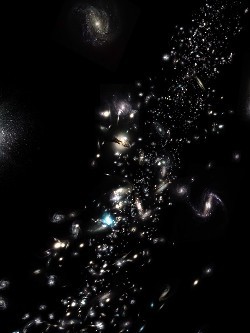Galaxies Help Weigh Neutrinos

In what seems an unfair fight, a team of researchers has enlisted thousands of galaxies to place the tightest bound yet on the mass of the wispy neutrino. Using data from an ongoing galactic survey, the group puts it at no more than a billionth of the mass of a hydrogen atom. The result, appearing in the 5 August print issue of PRL, means that the ubiquitous particles could account for at most one-eighth of the invisible dark matter suffusing the universe.
Neutrinos interact so weakly with everything else that their properties can’t easily be divined from accelerator studies. Nevertheless, recent years have seen the ghostly particles come into sharper focus by other means. Just this past March, results from the Sudbury Neutrino Observatory (SNO) strengthened the case that the three different kinds of neutrino–electron, muon, and tau–can interconvert. This flip-flopping implies that the particles have different masses, but the experiment couldn’t pin down their absolute heft.
Here’s where galaxies can help. Cosmologists have a good idea of how much matter there must be in the universe, but they don’t have an exact parts list because they can’t see or directly detect most of it. They can infer some details, however. The flatness of the universe indicates that most of the matter in it is invisible, or dark. And the distribution of galaxies suggests that most of these particles have been slow moving or cold for quite a while.
The colder the matter, the more gravity can gather it into stars, galaxies, and grander agglomerations. Neutrinos are a relatively hot form of dark matter. If they were too massive, matter would have to be less clumpy at small scales than we observe, explains Ofer Lahav, an astronomer at the University of Cambridge. However, “it’s worth asking to what extent we can hide massive neutrinos while still getting what we see in the sky,” he says.
So he, coworker Oystein Elgaroy, and other colleagues applied data from the 2dF Galaxy Redshift Survey, the largest of its kind, to the problem. They compared the observed shape in space of 160,000 galaxies to models of galactic distribution that incorporated various masses for the neutrino. Their results indicate that the particle must weigh less than 2.2 eV, whereas previous studies had put the ceiling at 3-6 eV, although with different cosmological assumptions. As a lower limit, the SNO data imply that at least one neutrino weighs in above 50 meV. Combining the future survey results with other cosmological data could narrow this range even further, they note.
“I think they did [the analysis] as well as you could,” says Wayne Hu of the University of Chicago, who first suggested this way to exploit galactic surveys. The main worry in interpreting the data, he points out, is that dark matter might not cluster the same way as visible matter does. The standard cosmological model assumes that these two components share the same shape. “If you’re a skeptic you could say we don’t understand how galaxies cluster,” he says. But a number of recent tests put to the model have shown that “everything is shaping up extraordinarily well.”
–JR Minkel
JR Minkel is a freelance science writer in New York City.


